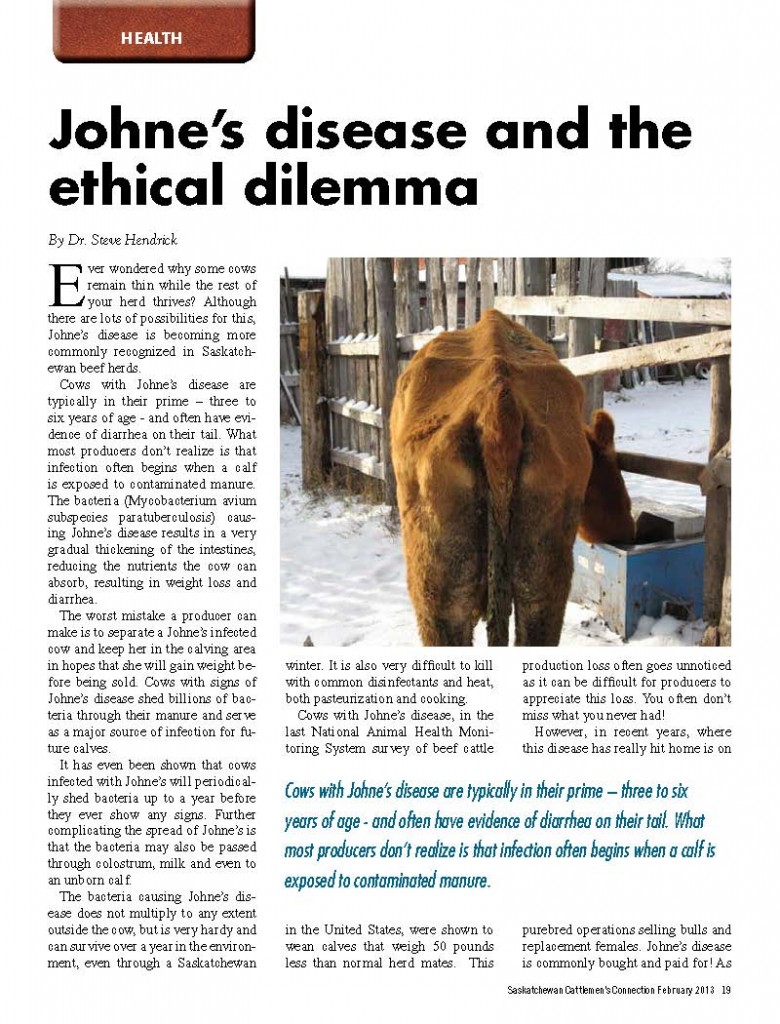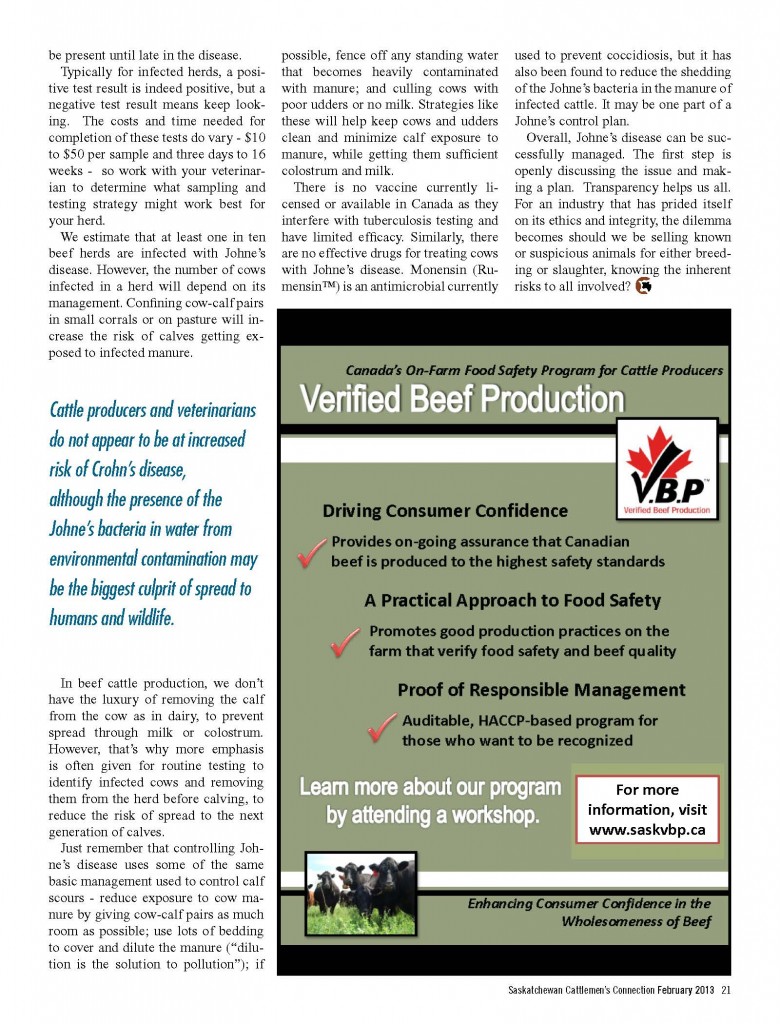Johne’s Disease and the Ethical Dilemma
This article written by Dr. Steve Hendrick, from the Western College of Veterinary Medicine at the University of Saskatchewan, originally appeared in the February 2013 issue of Saskatchewan Cattlemen’s Connection magazine and is reprinted with permission.
Ever wondered why some cows remain thin while the rest of your herd thrives? Although there are lots of possibilities for this, Johne’s disease is becoming more commonly recognized in Saskatchewan beef herds. Cows with Johne’s disease are typically in their prime (3 to 6 years of age) and often have evidence of diarrhea on their tail. What most producers don’t realize is that infection often begins as a calf when exposed to contaminated manure. The bacteria (Mycobacterium avium subspecies paratuberculosis) causing Johne’s disease results in a very gradual thickening of the intestines reducing the nutrients the cow can absorb and resulting in weight loss and diarrhea.
The worst mistake a producer can make is to separate a Johne’s infected cow and keep her in the calving area in hopes that she will gain weight before being sold. Cows with signs of Johne’s disease shed billions of bacteria through their manure and serve as a major source of infection for future calves. It has even been shown that cows infected with Johne’s will periodically shed bacteria up to a year before they ever show any signs. Further complicating the spread of Johne’s is that the bacteria may also be passed through colostrum, milk and even to an unborn calf.
The bacteria causing Johne’s disease does not multiply to any extent outside the cow, but is very hearty and can survive over a year in the environment, even through a Saskatchewan winter! It is also very difficult to kill with common disinfectants and heat (both pasteurization and cooking).
Cows with Johne’s disease, in the last National Animal Health Monitoring System survey of beef cattle in the United States, have been shown to wean calves that weigh 50 pounds less than normal herd mates. This production loss often goes unnoticed as it is can be difficult for producers to appreciate this loss. You often don’t miss what you never had! However, in recent years, where this disease has really hit home is on purebred operations selling bulls and replacement females. Johne’s disease is commonly bought and paid for! As producers become more informed and aware of Johne’s disease, they have started to ask the tough questions. The loss of market access is clearly the biggest struggle most producers face, which is why some continue to bury their head in the sand on this disease. Just remember, what goes around, comes around!
As an industry, the reason for concern with Johne’s disease is not just its production effects, but rather its risk as a cause of human disease. It is very likely that some cases of Crohn’s disease in people are associated with the bacteria causing Johne’s disease in cattle. Not only do the diseases appear similar in clinical signs, but even the damage in the gut. It has been identified that some people are genetically predisposed to Crohn’s disease, but the rate at which new infections are being diagnosed, suggests that an environmental factor is likely at play. Studies suggest that people eating meat and milk protein sources may be at increased risk, however, the retrospective nature of these studies makes them very susceptible to bias. Cattle producers and veterinarians do not appear to be at increased risk of Crohn’s disease, although the presence of the Johne’s bacteria in water from environmental contamination may be the biggest culprit of spread to humans and wildlife.
Testing for Johne’s disease can be an exercise in frustration! The tests do what they were designed to do: identify the bacteria or cow’s immune response against it. However, the bacteria in manure or antibodies in the blood may not be present until late in the disease. Typically for infected herds, a positive test result is indeed positive, but a negative test result means keep looking! The costs and time needed for completion of these tests do vary ($10 to $50 per sample; 3 days to 16 weeks), so work with your veterinarian to determine what sampling and testing strategy might work best for your herd.
We estimate that at least one in ten beef herds are infected with Johne’s disease. However, the number of cows infected in a herd will depend on its management. Confining cow-calf pairs in small corrals or on pasture will increase the risk of calves getting exposed to infected manure. In beef cattle production, we don’t have the luxury of removing the calf from the cow as in dairy to prevent spread through milk or colostrum. However, that’s why more emphasis is often given for routine testing to identify infected cows and removing them from the herd before calving to reduce the risk of spread to the next generation of calves.
Just remember that controlling Johne’s disease uses some of the same basic management used to control calf scours: reduce exposure to cow manure by giving cow-calf pairs as much room as possible, perhaps using lots of bedding to cover and dilute the manure (“dilution is the solution to pollution!”), and if possible, fence off any standing water that becomes heavily contaminated with manure, culling cows with poor udders or no milk. Strategies like these will help keep clean cows and udders, and minimize calf exposure to manure while getting them sufficient colostrum and milk.
There is no vaccine currently licensed or available in Canada as they interfere with tuberculosis testing and have limited efficacy. Similarly, there are no effective drugs for treating cows with Johne’s disease. Monensin (Rumensin™) is an antimicrobial currently used to prevent coccidiosis, but it has also been found to reduce the shedding of the Johne’s bacteria in the manure of infected cattle and may be one part of a Johne’s control plan.
Overall, Johne’s disease can be successfully managed. The first step is openly discussing the issue and making a plan. Transparency helps us all. For an industry that has prided itself on its ethics and integrity the dilemma becomes should we be selling known or suspicious animals for either breeding or slaughter knowing the inherent risks to all involved?
Learn more
- Johne’s Disease (BCRC Web page)
We welcome your questions, comments and suggestions. Contact us directly at info@beefresearch.ca or generate public discussion by posting your thoughts below.
Stay connected by following us on Twitter @BeefResearch, liking us on Facebook, and subscribing to our YouTube Channel.


